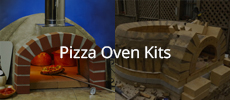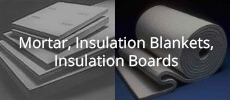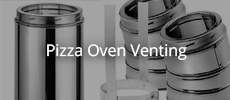Hello everyone!
After rigorous reading up on home built pizza ovens I find myself here. My plan is to build a Pizza oven over the course of the summer, the whole premise is to have a fun little project that wont be too expensive but will last for years, not necessarily a lifetime, 10 years would be fantastic. I really need your help deciding on the right design for me and how to execute it!
The only part that is decided is the 80 cm biscotto tiles for the floor. I will build on top of a sand form by Neapolitan design with a low roof (Ø85cm,29cm high and 18 cm opening)
The options I see:
1. A solid cement : perlite oven. 6cm 1:5 mix, chicken wire, 5cm 1:6 mix, chicken wire, 4-8cm 1:6 mix (finishing shape layer), waterproof mono-coat, render, mosaic. From what I have seen thick reinforced perlite ovens are the most successful ones. I understand that cement is not optimal under high heat but still I see successful ovens made this way, it seems beneficial that the ovens seem to slowly crumble rather than just crack and some seem to be quite stable! Benefits; homogenous material reduces stress from heat, perlite is stable under heat, high insulation limits the parts affected by high heat, easy/inexpensive. What do those of you who use this kind of oven say, does it last, have you done alterations to your mix, are you able to repair them? Is there alterations I could do to this recipe? I have been pondering adding clay or lime and adding some fibers like straw to add strength to the insulation layer. Concerns; I have seen some real horror examples made this way (often involving an inflatable pilates ball), however some of these where clearly missing any reinforcement hence its hard to judge which one is a well built example actually failing.
2. The forum favorite homebrew fire layer perlite oven. 5cm 3:1:1:1 homebrew with AR glass fibers, 4cm 1:6 mix, chicken wire, 4cm 1:6 mix, chicken wire, 4-8cm 1:6 (finishing shape layer), waterproof mono-coat, render, mosaic. This is one I see a lot of people going for in this forum. Benefits; Fire resistant layer, hard durable inner layer, added thermal mass, not too expensive (if it works). Easy to repair. Is there anyone that have a design of a homebrew that have lasted you for some years? What other alterations can you do to the homebrew, I have been thinking about adding grog (crushed ceramics) for increased thermal stability. Concerns; I have seen examples here where the homebrew cracks quite severely. The homebrew might be prone to chipping of the structural perlite layer? It is difficult to reinforce the homebrew I have not seen finished examples of AR glass, anyone know of any? AR glass is hard to come by and expensive (probably worth it). Two casted layers that expands differently under thermal stress. I have a lot of hope on this option but not without some fear of that the added complexity might make it both more laborious and more prone to failing. You who have made a homebrew oven what did you learn and what is key to a good design? In some blacksmith forums I have read about mixing silica sand, cement, clay, perlite, and hydrated lime, anyone who has tried? I have also read about Sodium Silicate is this a longevity enhancer?
3. The cob(1:2 clay:sand mix) perlite oven! 5cm cob, 5cm clay perlite straw 1:4:1, chicken wire, 8cm clay perlite straw 1:4:1, render, mosaic, roof! . Benefits; easy to work non toxic materials, repairable, reusable( if the oven becomes too cracked its just to crush it up, add water, mix and build up again! I don't see that many cob/clay ovens using perlite, is there any here who have some experience? Concerns; It will crack (from experience) but probably not fatal, not as insulated, unsure about the compatibility with perlite and mixing ratios, longevity might be limited (at least traditional cob ovens)
I am grateful for any insights you might have! I am open for other suggestions too! I see the low thermal mass of perlite as a benefit in my situation, with faster upstart times and fuel efficiency in comparison to a chunky brick oven. Since the biscotto tiles, stainless chimney and base is reusable its not the end of the world if the dome fails. But I really hope not. I will cover it with a sown tarp when I am not using it to keep the oven out of the elements.
If you made it all the way thank you!
Best regards
Rasmus
After rigorous reading up on home built pizza ovens I find myself here. My plan is to build a Pizza oven over the course of the summer, the whole premise is to have a fun little project that wont be too expensive but will last for years, not necessarily a lifetime, 10 years would be fantastic. I really need your help deciding on the right design for me and how to execute it!
The only part that is decided is the 80 cm biscotto tiles for the floor. I will build on top of a sand form by Neapolitan design with a low roof (Ø85cm,29cm high and 18 cm opening)
The options I see:
1. A solid cement : perlite oven. 6cm 1:5 mix, chicken wire, 5cm 1:6 mix, chicken wire, 4-8cm 1:6 mix (finishing shape layer), waterproof mono-coat, render, mosaic. From what I have seen thick reinforced perlite ovens are the most successful ones. I understand that cement is not optimal under high heat but still I see successful ovens made this way, it seems beneficial that the ovens seem to slowly crumble rather than just crack and some seem to be quite stable! Benefits; homogenous material reduces stress from heat, perlite is stable under heat, high insulation limits the parts affected by high heat, easy/inexpensive. What do those of you who use this kind of oven say, does it last, have you done alterations to your mix, are you able to repair them? Is there alterations I could do to this recipe? I have been pondering adding clay or lime and adding some fibers like straw to add strength to the insulation layer. Concerns; I have seen some real horror examples made this way (often involving an inflatable pilates ball), however some of these where clearly missing any reinforcement hence its hard to judge which one is a well built example actually failing.
2. The forum favorite homebrew fire layer perlite oven. 5cm 3:1:1:1 homebrew with AR glass fibers, 4cm 1:6 mix, chicken wire, 4cm 1:6 mix, chicken wire, 4-8cm 1:6 (finishing shape layer), waterproof mono-coat, render, mosaic. This is one I see a lot of people going for in this forum. Benefits; Fire resistant layer, hard durable inner layer, added thermal mass, not too expensive (if it works). Easy to repair. Is there anyone that have a design of a homebrew that have lasted you for some years? What other alterations can you do to the homebrew, I have been thinking about adding grog (crushed ceramics) for increased thermal stability. Concerns; I have seen examples here where the homebrew cracks quite severely. The homebrew might be prone to chipping of the structural perlite layer? It is difficult to reinforce the homebrew I have not seen finished examples of AR glass, anyone know of any? AR glass is hard to come by and expensive (probably worth it). Two casted layers that expands differently under thermal stress. I have a lot of hope on this option but not without some fear of that the added complexity might make it both more laborious and more prone to failing. You who have made a homebrew oven what did you learn and what is key to a good design? In some blacksmith forums I have read about mixing silica sand, cement, clay, perlite, and hydrated lime, anyone who has tried? I have also read about Sodium Silicate is this a longevity enhancer?
3. The cob(1:2 clay:sand mix) perlite oven! 5cm cob, 5cm clay perlite straw 1:4:1, chicken wire, 8cm clay perlite straw 1:4:1, render, mosaic, roof! . Benefits; easy to work non toxic materials, repairable, reusable( if the oven becomes too cracked its just to crush it up, add water, mix and build up again! I don't see that many cob/clay ovens using perlite, is there any here who have some experience? Concerns; It will crack (from experience) but probably not fatal, not as insulated, unsure about the compatibility with perlite and mixing ratios, longevity might be limited (at least traditional cob ovens)
I am grateful for any insights you might have! I am open for other suggestions too! I see the low thermal mass of perlite as a benefit in my situation, with faster upstart times and fuel efficiency in comparison to a chunky brick oven. Since the biscotto tiles, stainless chimney and base is reusable its not the end of the world if the dome fails. But I really hope not. I will cover it with a sown tarp when I am not using it to keep the oven out of the elements.
If you made it all the way thank you!
Best regards
Rasmus





Comment